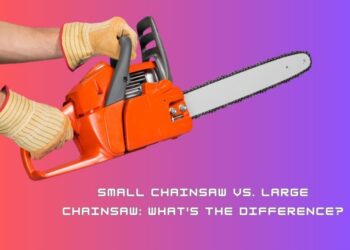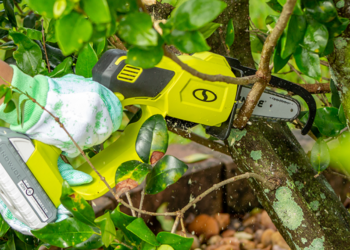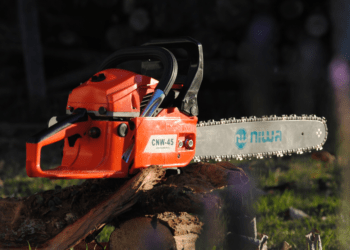Saws have been in the hands of woodworkers for thousands of years, evolving to fit specific needs as time, technology, and materials changed. Today’s “complete” toolset will include a variety of saws, ranging from coping saws to hacksaws to a variety of specialised table saws, and may include multiple saws of the same type. Here are 32 different varieties of saws, their uses, and pictures without further ado:
Handsaws
Backsaw
The name “backsaw” comes from the meaning that it is a short saw with a narrow blade. Mitre boxes and other applications that require a consistent fine, straight cut are common uses for backsaws. Depending on the saw design, intended use, and region, back saws are also known as mitre saws or tenon saws.
No products found.Bow Saw
The bow saw another type of crosscut saw, is more at home outside than inside. It has a long blade with many crosscut teeth that are designed to remove material while pushing and pulling. Bow saws are commonly used for tree trimming, pruning, and log cutting, but they can also be used for other rough cuts.
No products found.Coping Saw
The coping saw is essentially made for trim work, scrolling, and any other cutting that requires precision and intricate cuts, thanks to its thin, narrow blade. Coping saws can cut a wide range of materials and are found in the toolkits of everyone from carpenters to plumbers to toy and furniture makers.
No products found.Crosscut Saw
This saw has a thick blade with big, bevelled teeth that is designed specifically for rough cutting wood. Traditional 2-man crosscut saws (also known as felling saws) have a handle on each end and are designed to cut across (perpendicular) the grain of wood by two people. It is great for rough cutting lumber, trimming limbs or branches, and is a great camping or job-site saw.
No products found.Fret Saw
The fret saw, which is very similar to a coping saw, has a long, thin blade for making accurate and detailed cuts. This saw has a longer, larger frame that helps you to cut further away from the edges, however, the blade cannot be rotated, which makes it tedious to use in cutting positions when performing intricate scrollwork.
No products found.Hacksaw
It is one of the most common saw types, and it’s ideal for cutting pipes and tubing. They’re small and light, and they can cut through wood, metal, plastic, and other materials with material-specific cutting blades that have tooth counts ranging from 18 to 32 per inch.
No products found.Hole Saw
With a hole saw and a drill, you can cut perfect circular holes in wood, metal, concrete, stainless steel, plastic, and other materials. You’ll need to use a hole saw if you don’t have a large enough spade bit. The material of the blade varies depending on the material to be cut. Although bi-metal hole saws are the most versatile, cutting harder materials often necessitates the use of carbide or diamond coated teeth.
No products found.Japanese Saw
This type of saw, which has a single handle and a protruding strong, thin cutting blade, is more accurate than a backsaw and has the advantage of reaching places where other saws cannot. These saws come in three different types (dozuki, ryoba, and kataba), and they can cut both hard and softwoods with equal precision.
No products found.Keyhole Saw
A keyhole saw, which has a round handle with a single blade protruding from the top, is used to roughly cut circles or patterns. When a small section of drywall needs to be removed and/or replaced, or when the interior of the wall prevents the usage of powered tools, keyhole saws can be invaluable.
No products found.Pole Saw
It has an extendable pole that reaches 7 to 16 feet (or more) depending on the model. At the cutting end is a six to eight inch pruning blade designed for trimming trees.
No products found.Pruning Saw
A 13-15′′ curved blade protrudes from a single “pistol grip” style handle on most pruning saws. For faster material removal, the blade is wide and has coarse teeth that can cut in both directions. Many of these saws are now powered, with a chainsaw-like end and a fuel source of gas or electricity.
No products found.Rip Cut Saw
The rip cut saw, also known as a “hand saw,” is an essential tool for framing. It has a small number of teeth per inch, but each one is a sharpened point for removing wood. Anyone who works with wood has at least one rip cut saw, which is usually of varying lengths.
No products found.Veneer Saw
The veneer saw is another highly specialised saw with a short double-edged blade with about 13 teeth per inch. This saw is designed specifically for precision veneer work, and its short blade prevents it from being used for most other cutting tasks.
No products found.Wallboard Saw
The wallboard saw, which resembles a keyhole saw in appearance, has a shorter, wider blade with fewer teeth per inch and is frequently double-edged. It’s made for piercing panelling or drywall, and it’s frequently used to make starter holes for powered tools.
No products found.Power Saws
Stationary Band Saw
A continuous band with fine teeth is moved by large pulleys above and below the cutting table to cut through most materials in this tall, floor-standing saw. Band saws are ideal for cutting intricate curves in wood, as well as tubes, piping, and PVC, but they can only cut to a depth of a few inches.
No products found.Portable Band Saw
It’s a small portable version of the stationary unit that can do most of the same jobs as its big brother, but with the added convenience of being able to transport it to a jobsite or someone else’s garage.
Of course, you’re limited in what you can cut (typically 3-4′′ diameter pipes) and making straight cuts takes more effort, but it can be an invaluable tool for plumbers, welders, and metalworkers.
No products found.Chain Saw
As the name implies, chainsaws utilize a chain with numerous specially designed teeth designed to rip. Despite their unique design, chainsaws are considered band saws. Chainsaws are used more frequently in tree work than in any other field, so homeowners may need them depending on where they live.
No products found.Chop Saw
The chop saw is one of the biggest circular saws available, which is available in both metal and masonry cutting versions. The concrete cutting saw is often equipped with a water line to reduce dust while cutting. Chop saws with toothless blades are made with special abrasives designed for the materials to be cut in both types. They can also called cut-off saws, concrete saws, and abrasive saws.
No products found.Circular Saw
Circular saws, also known as buzz saws or by the brand name Skilsaw, have a toothed blade that is typically between 7-14 and 9 inches in diameter. They are the most used powered saw, and blades for cutting wood, metal, plastic, masonry, and other materials are available.
No products found.Compound Miter Saw
This is a mitre saw on a higher level. Straight, mitre, and compound cuts are all made with compound saws. Instead of pivoting up and down like miter saws, the blade is mounted on an arm that adjusts for complex angles, including scrollwork and trim cuts. Whether you’re trimming windows or installing crown molding, the compound miter saw is one of the most useful tools you can own.
No products found.Flooring Saw
A flooring saw, as the name implies, is a portable tool used to re-saw flooring (hardwood, engineered, bamboo, or laminate) to fit. It’s a specialised tool that, in effect, replaces a table saw, mitre saw, and other flooring-cutting accessories. Its biggest advantage is portability, as you won’t have to spend as much time moving materials from garage to room and vice versa when installing flooring.
No products found.Jigsaw
A short, fine-toothed blade moves up and down at variable speeds on this handheld saw. There are few saws that can be used to cut curves and other non-straight lines. Look for a jigsaw that has a long cord or even one that is cordless.
No products found.Mitre Saw
The mitre saw is one of the few saws designed to closely resemble a hand saw. It’s great for trimming and other jobs that require precise measurements and angle cuts. A simple mitre saw can pivot up to 45 degrees on either side of a straight 90-degree cut, and it can be used with tables to cut long mitred ends.
No products found.Oscillating Saw
It’s also known as an oscillating multi-tool or oscillating tool, and it has a grinder-like body with an oscillating attachment that can be changed out depending on the job. It’s often regarded as the reciprocating saw’s more versatile sibling. One company even sells sanding pads for their OMT.
No products found.Panel Saw
These table saw relatives, which come in both vertical and horizontal alignments, are designed to cut large panels. Vertical models either require you to place the material or have a blade that moves through a stationary panel, whereas horizontal models use a sliding feed table. Cabinetmakers, sign makers, and other industries use panel saws frequently.
No products found.Radial Arm Saw
The radial arm saw helps you make very similar compound cuts, mitre cuts, and more by mounting the motor and blade on an arm that extends over the cutting table. Radial arm saw blades can be interchangeable with circular saw blades, depending on the manufacturer; however, check the recommended spin speed, as some radial saws spin very quickly.
No products found.Reciprocating Saw
This saw, like the jigsaw, has a blade that moves back and forth quickly. Reciprocating saws are sometimes referred to as Sawzall®, after the company that invented them. They’re used to cut tubing, wood, and plastics, as well as cutting beneath walls or wood joints because the blades can cut both nails and wood. For demolition work, this is a must-have tool.
No products found.Rotary Saw
A fixed blade and a small screwdriver-style handle characterise rotary saws (or rotary tools). They’re perfect for cutting into a wall for access or repairs, and they’re used for everything from crafts to construction. A rotary saw, like a keyhole saw, is essential for drywall, panelling, and a variety of other small cutting jobs.
No products found.Scroll Saw
Scroll saws can use a band, continuous, or reciprocating blade to cut wood. These powered saws, like coping saws, are made for intricate scrollwork, spiral lines, or patterns. They also have a table on which the material can be laid while being cut, allowing for precise rotation and detail. It excels at generating curves with edges.
No products found.Table Saw
Table saw blades are slightly larger than circular saw blades and feature a high-speed motor mounted beneath a flat table. The blades emerge from the table bed to adjust the cut depth. Table saws are ideal for making a large number of identical rip cuts or preparing a large number of identically sized pieces. Metal and masonry blades are compatible with these saws, but make sure the blade design matches the motor rpm.
No products found.Tile Saw
A tile saw is similar to a mitre saw in that it uses a diamond-coated blade and a water cooling system to cut through tiles like butter. It uses a mitre to ensure straight cuts along with your cut marks and is used to quickly cut multiple ceramic or porcelain tiles to the desired shape or size. On some models, changing the blade will even allow you to cut glass. Before using this tool, make sure the reservoir beneath the table is full of water.
No products found.Track Saw
The track saw (or plunging saw) is a more powerful version of a table and circular saw that can be attached to a long gliding rail. Its appearance is more similar to that of a circular saw, making it more portable. Simply align the sticky-backed track with your cut line (which is visible through the track) and secure the saw on its rails. With almost no effort, it’ll glide smoothly along the rail, creating a perfect cut.
No products found.Conclusion
This concludes the list of 32 different types of saws and how they can help you climb the ladder of woodwork and carpentry. Make sure you go through the pros and cons of each saw before you make a decision to buy one.









